The Lexus GX has long been a favorite of people who preferred more of a classic and rugged luxury experience. But it had also been 13 years since the last major redesign, meaning it was long in the tooth, until now with this all-new generation! Oddly enough, there’s also an SUV in the Toyota lineup with essentially the same exact story; the recently redesigned Sequoia. Although they aren’t the same size, they do share the same tough body-on-frame platform, the same dedication to luxury, and, surprisingly, the same price tag. So, who wins in this 2024 Lexus GX 550 vs. Toyota Sequoia battle? Let’s find out!
Pricing and Equipment
Now before we get into it, let’s get into the pricing, which I think will surprise you.
Beginning with the all-new GX 550, we have the fully loaded version which is called the Luxury+ trim. This version starts a bit under $80,000 and after we add a few extra options, we arrive at $83,895.
MSRP (Luxury+ 4WD): $79,900 | Options: $2,645 | Destination: $1,350 | Total: $83,895
What I think will surprise you is the Sequoia’s price tag being nearly identical. This loaded Capstone also rings in at over $83,000.
MSRP (Capstone 4×4): $81,265 | Options: $455 | Destination: $1,850 | Total: $83,627
If you want to find the best prices in your local area on new vehicles and see invoice pricing information, make sure to check out our tool here.
So, with prices that are only $200 apart, let’s get into this objectively-scored comparison.
Exterior Design
We will start off with the outsides, which are obviously going to be quite different. One thing that’s the same is that both of them have large grilles and very premium full LED lighting, but otherwise all the details are different. The Sequoia Capstone goes for a classic luxury look with lots of blingy chrome throughout, while the new GX looks tougher.
Speaking of toughness, both these SUVs are body-on-frame and can certainly handle going off the beaten path with 8.7-inches of ground clearance. Of course, if off-road performance is your #1 priority, then the TRD Pro and Overtrail models will be more suitable than these luxury specs.
- SEQ: 8.7-inches
- GX: 8.7-inches
One small premium detail that only the Toyota has is dynamic turn signals.
Heading on around, both will include large multi-spoke 22-inch alloys, which look nice against the boxy side profiles. And this would be a great time to mention how they size up against each other. Even though they share the same basic platform, lengthwise we have a full-size SUV and a mid-size SUV. We will see how this impacts interior space later in this comparison, but for now just know that they are separated by about 10 inches.
Lengths: Sequoia: 208.1-inches | GX: 197.4-inches
As we move to the back, both continue to reflect boxy designs, punctuated by squared-off LED taillights. Functionally, it’s the Sequoia that can tow more, with the Capstone 4WD coming it at nearly 9,000 lbs vs. 7,800 lbs in the GX Luxury+.
Additional Features
Now as far as some other features, both have fully loaded mirrors, and they both also have the latest safety packages, which include every single active safety system as standard equipment. Only traffic jam assist is optional on the Lexus.
Warranty-wise, both have reputations of being bullet-proof, but if you need to utilize them, the Lexus has the longer one for both basic and powertrain.
LEX: Warranty: Basic Warranty: 4yr/50k mi | Powertrain: 6yr/70k mi | Comp Main: 2 visits
SEQ: Warranty: Basic Warranty: 3yr/36k mi | Powertrain: 5yr/60k mi | Comp Main: 2yrs/24k
As cool as the exteriors are, we still have some super-luxurious interiors to explore!
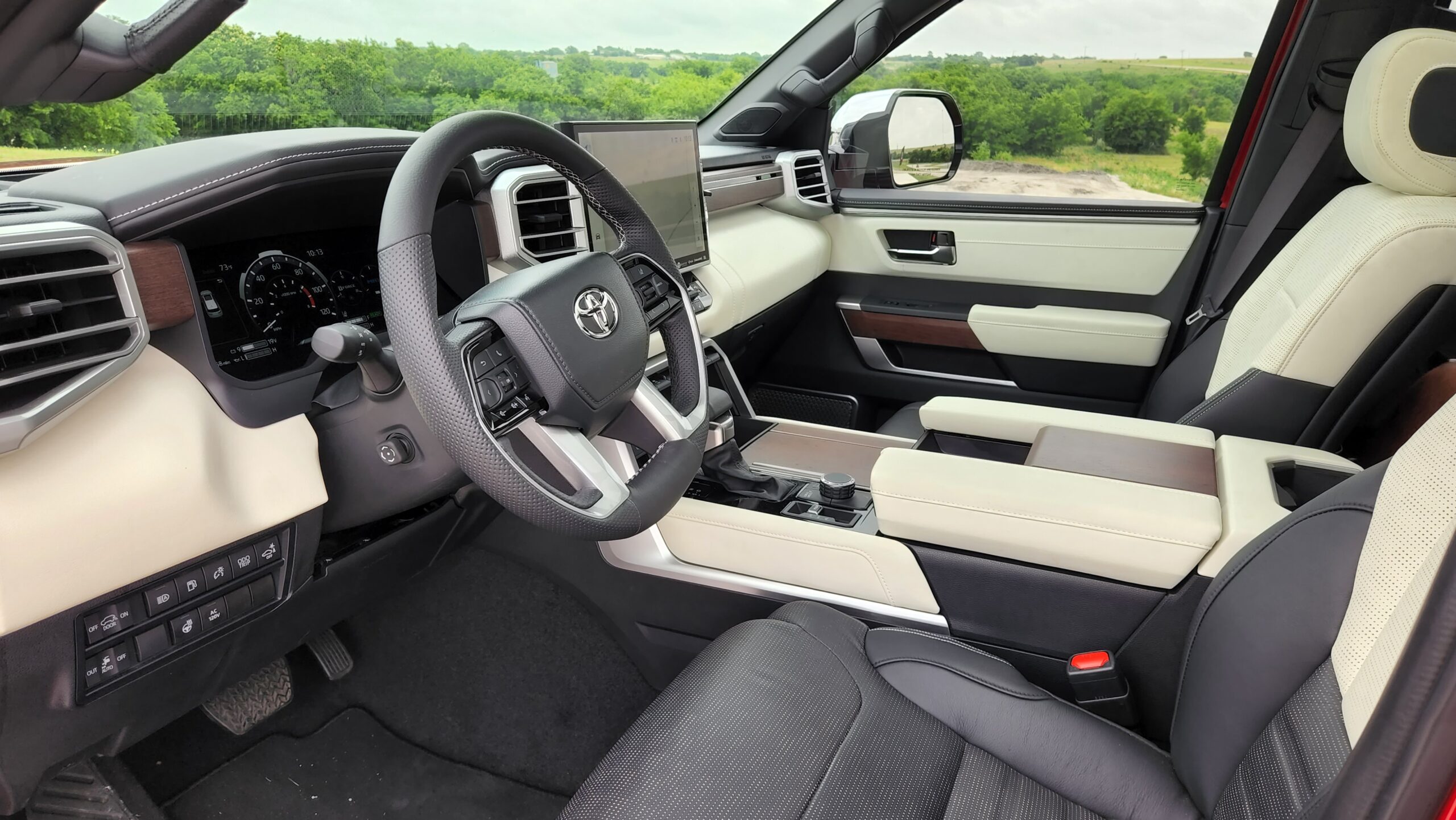
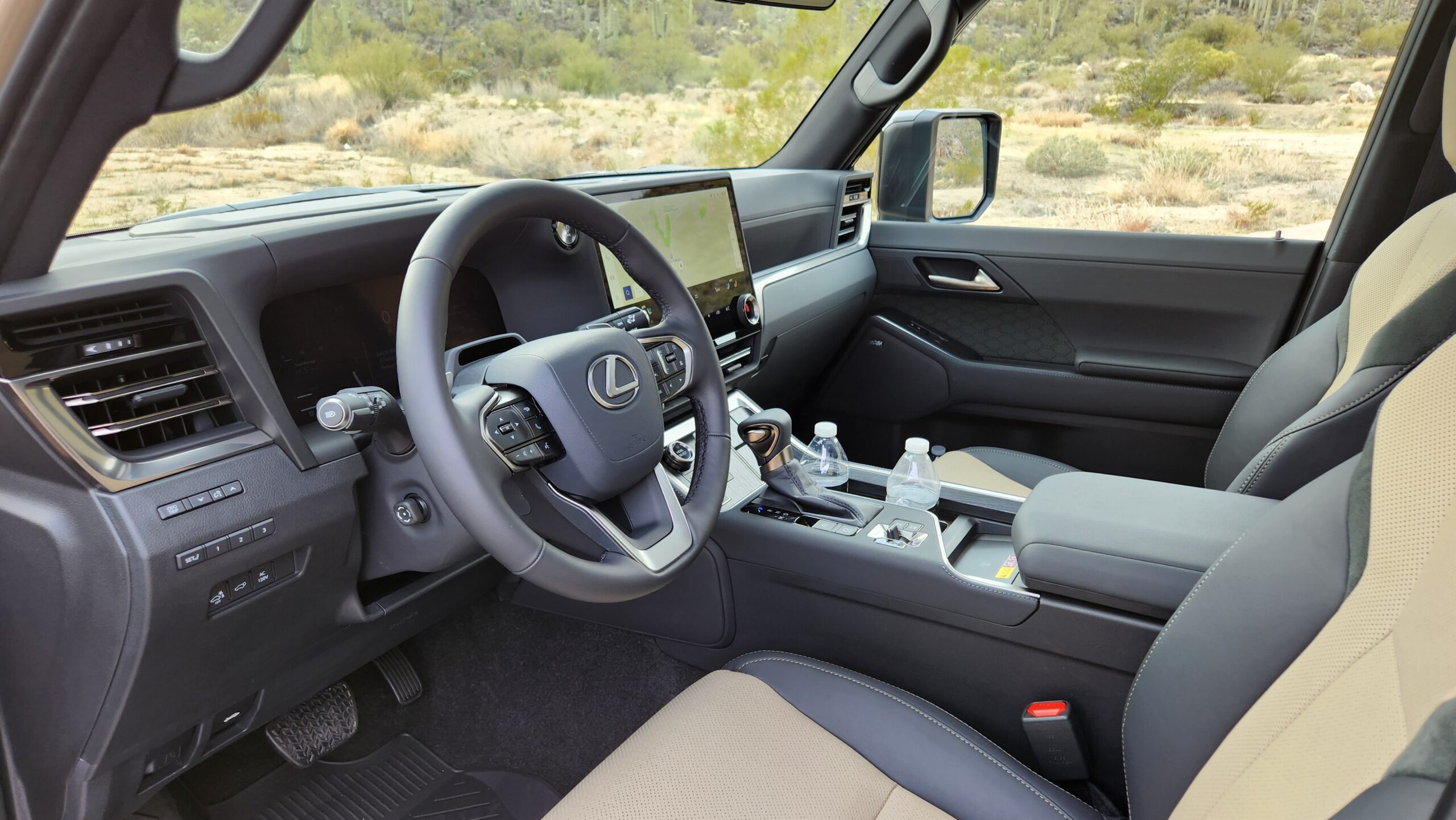
Interior Design
So, walking up the vehicles, both are obviously going to have smart entry systems to unlock the doors, and the new GX now has power deploying running boards just like the Sequoia.
Now checking out the interiors themselves, as you can see, both look luxurious and have boxy design themes. In the Capstone, we have a lovely 2-tone black and white semi-analine leather interior, which is the only way you can get this trim and in the GX 550 we also have semi-analine leather seating finished in the Tan option.
As far as the seats themselves, they are both heated and ventilated with memory functions and plenty of adjustments, although I’m surprised to see only 2-way lumbar on the GX.
The Lexus fights back though by having massaging abilities for both front seats, which is something that the Toyota doesn’t offer.
Let’s fully climb inside and talk about the overall cabin materials. This, like the lumbar, did take me by surprise because in many ways it’s the Toyota that delivers more luxury. You can visually see that it has a lot of real walnut wood trim throughout the cabin, while the Lexus has a limited amount on the center console. The Toyota also has leatherette trim across the tops of the door trims and dash while the GX uses soft touch plastic. Overall, while both are nice, the Sequoia will leave you feeling more spoiled.
Now after we start them up, you will be greeted by two 12.3-inch displays that get different graphics, and when you look up, there are also vivid head up displays projected out.
As 80,000 SUV’s, we also have the expected rain-sensing wipers, and power adjusting steering wheels with heating.
Storage and Technology
Now the next major area to evaluate is interior storage, where we have big differences. First, to be clear, our Lexus has the optional cool box refrigeration system, something that Toyota doesn’t offer but eats into the space.
But, even if the GX had the normal console, the Sequoia is still offering even more space, with a wide and deep center console, plus more space in front of the shifter.
Note: both of them have wireless phone charging pads
Speaking of shifters, going against the trend of electronic shifters, both SUV’s have traditional ones, and when you shift into reverse, they both display 360-degree cameras. Resolution and angle selections are top notch.
For the climate controls, we do have some differences. While they have the same number of adjustments, the Lexus comes with the climate concierge system, which automatically decides things like the heated and vented seats, and heated steering wheel.
Alrighty, that brings us to the audio systems, so let’s sample them. The Sequoia’s JBL is decent but the GX’s 21-speaker Mark Levinson is truly top notch and really impresses.
GX: 21-speaker Mark Levinson Premium audio
SEQ: 14-speaker JBL Premium audio
Now moving on to the screens, these are obviously very important aspects of a modern interior, and they are largely the same. In both the Toyota and the Lexus, we have 14-inch touchscreen panels, but I do think it should it be noted that the climate controls take up a decent amount of the GX’s real estate, so the Sequoia feels larger.
Both of them though are running the latest version of Toyota’s new software, which includes dynamic built in navigation, as well as wireless AA and ACP.
Up above, both SUV’s include digital camera rearview mirrors, and both also have panoramic sunroofs but with some differences. In the Lexus it’s actually a single piece of glass that cannot open like the Sequoia, but it also has a cool technology that can turn it opaque or clear at the touch of a button.
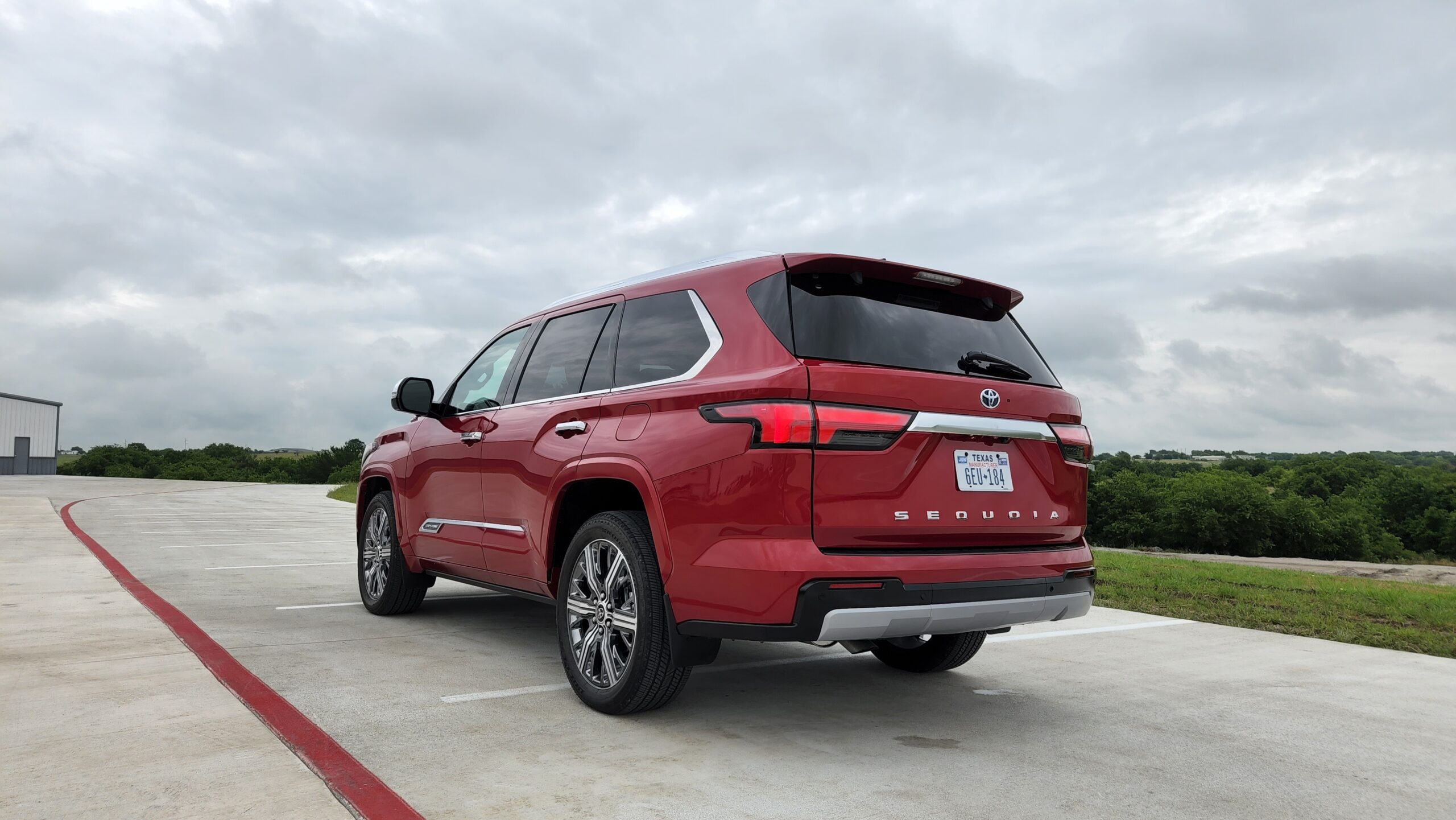
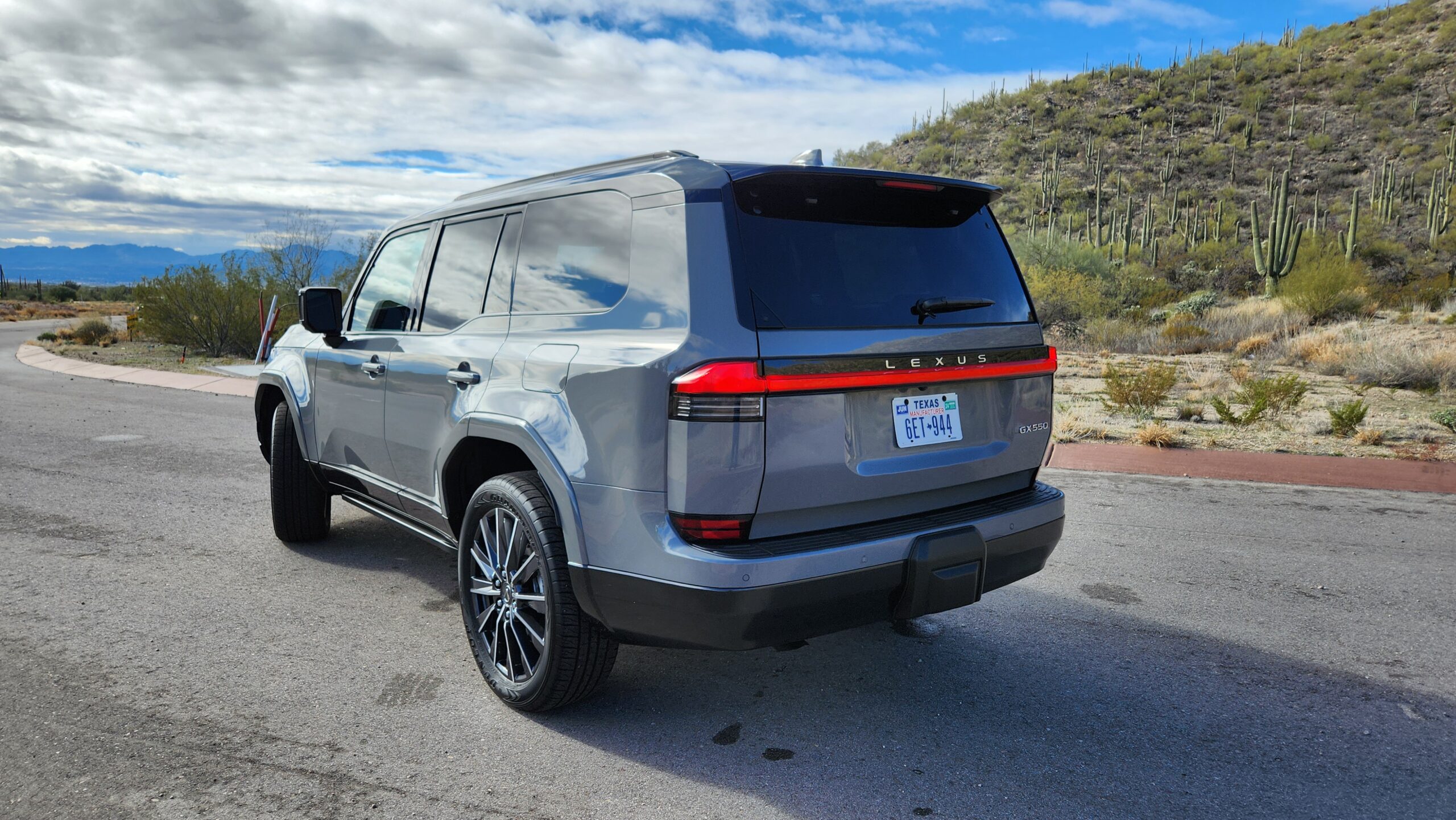
Rear Seats and Cargo
Even though both are large SUV’s, one is considered a mid-sizer and the other a full sizer. So now that we are in the back, you are obviously going to see some differences here. Starting with official specifications, the Toyota will have about 3-inches more legroom and 3-inches more headroom in the back. Both of those differences are above the 5% difference to score a point.
GX: 36.7-inches of legroom | 35.4-inches of headroom
SEQ: 39.2-inches of legroom | 38.4-inches of headroom
But since these are giant 3-row SUV’s, there is still a lot to talk about in the back seats. We have captain’s chairs on both examples today, along with climate controls, heated seats and window sunshades. The seats are also ventilated on the Sequoia but not the GX. Under the climate controls, the Toyota also has an additional household power outlet beyond the USB ports.
Now let’s move on to the third rows. First and foremost, the GX can only seat 2 across for a total of 6 passengers as equipped today, while Sequoia goes 3 deep for a total of 7.
Note: the GX Overtrail trims do not have third rows
Now as far as space and comfort in the way back, both have pretty good legroom measures, with the Toyota having about a 6% advantage when its sliding seats are pushed all the way back.
Headroom measures are the same and neither of them have great thy support due to the tougher, old school suspension setup both have gone to.
GX: 31.8 inches of legroom | 35.3 inches of headroom
Sequoia: Legroom: 28.1-33.7 inches | Headroom: 35.6 inches
Features wise, both have USB ports but only the Toyota keep sunshades back here as well.
Moving around back to the cargo, both have hands-free power tailgates, and can pop the rear glass independently.
Once open, the Sequoia’s extra length pay dividends. Each of the three seating configurations has more space in the Sequoia, and maximum cargo capacity ends up with a 12% advantage.
GX: Behind 3rd Row: 10.3 cu.ft | 2nd Row: 40.2 cu.ft | Max: 76.9 cu.ft
SEQ: Behind the 3rd row: 22.3 cu.ft | 2nd row: 49.0 cu.ft | Max: 86.9 cu.ft
Now let’s take them out on the road and see how they stack up there!
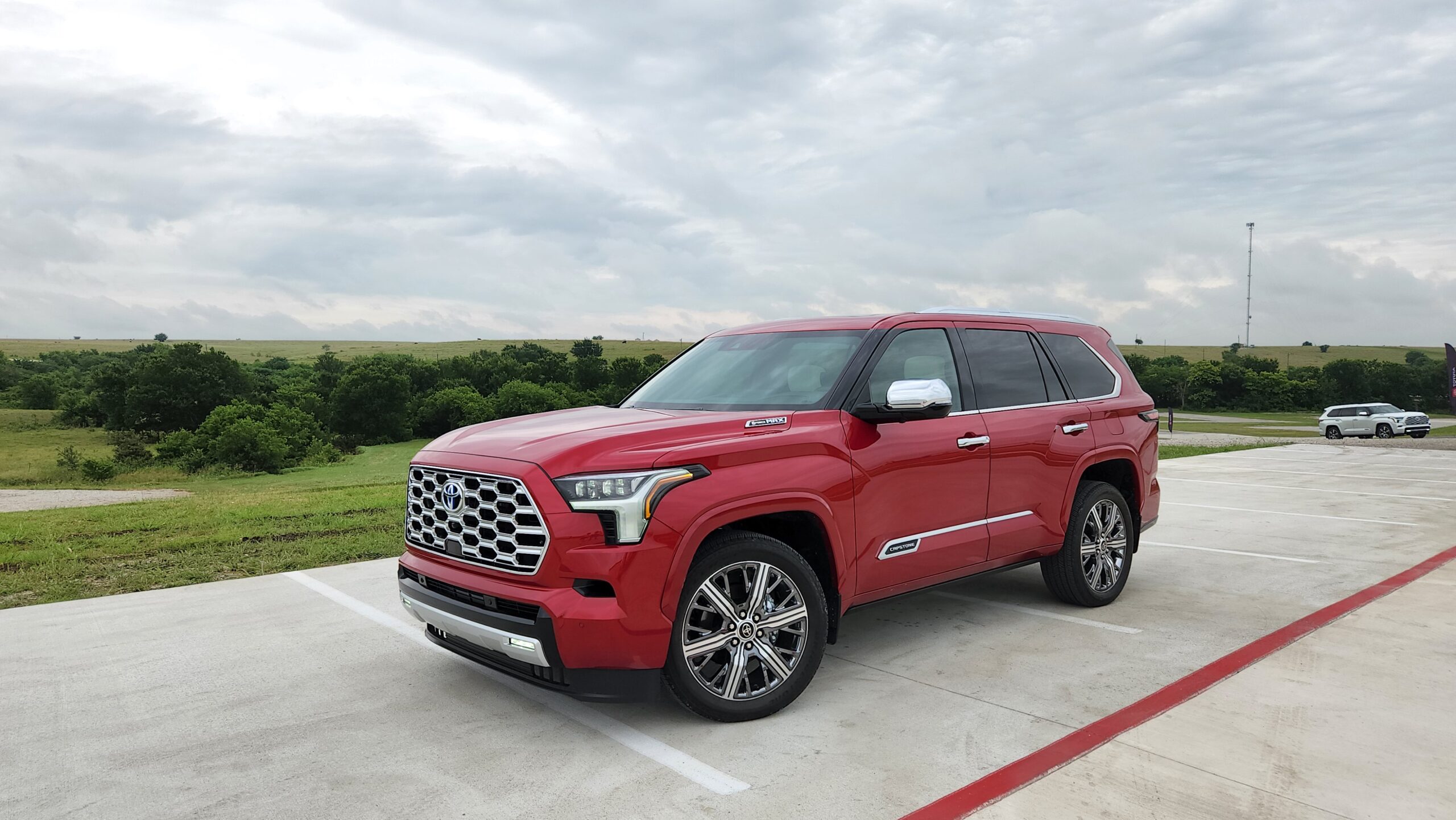
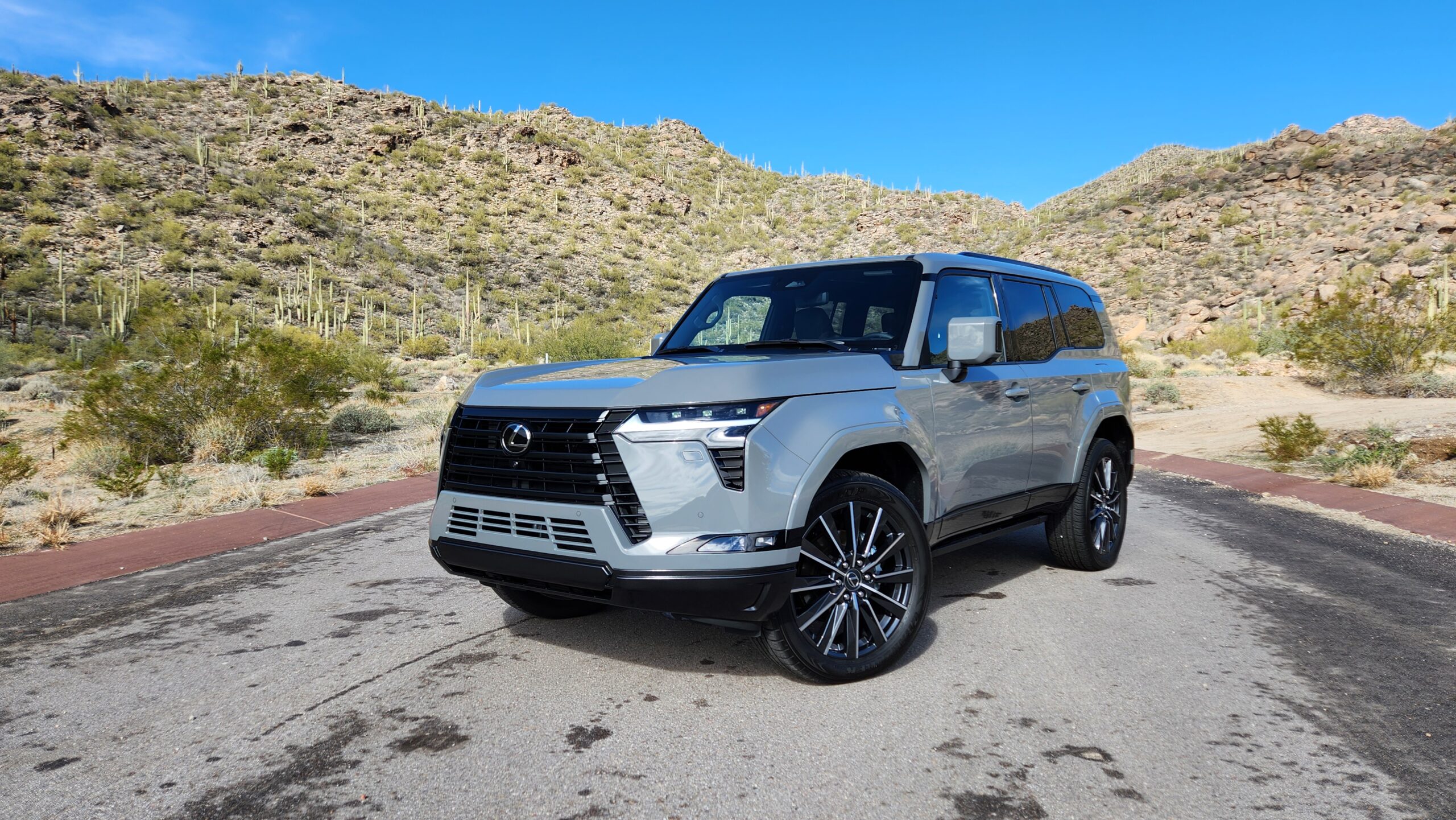
Powertrains
So, throughout the video, some things these two have in common and some they don’t, and that same principle applies under the hood. The engine you will find is part of the same twin-turbo V-6 family, but the Toyota is also hybridized. While the GX is also promised to have a hybrid, there are no details about this model currently, so right now the Toyota will have about 20% more power.
GX: Engine: 3.4L Twin-turbo V-6: 349 hp | 479 lb.ft of torque
SEQ: 3.5L Twin-Turbo V-6 + electric motor, nickel-hydride battery: 437 hp and 583 lb.ft
As far as the transmissions are concerned, both have the same 10 speed automatic transmission, which is nice and responsive.
Test Drive and Fuel Economy
But perhaps as important as power and responsiveness, is ride quality. Both models are using adaptive dampers which isolate out all the largest imperfections very well. They are still body-on-frame SUV’s though, so the smaller vibrations find their way into the cabins.
Here at Car Confections, something we like to do is take sound level readings for all the models we test so that we can compare them. At 55 MPH the Sequoia has a pretty serine environment measuring in at 57.9 dB. The GX comes in at 59.6, although that is an unofficial measurement since we had to take it on a rough Arizona road during a recent press trip. We still wanted to include that for your reference until we can get a GX back to Kentucky for another official test.
GX: 59.6 dB @ 55 MPH (Arizona)
SEQ: 57.9 dB @ 55 MPH
Finally, when it comes to fuel economy, even though the Toyota’s hybrid system is designed for power more than efficiency, it still wins over the non-hybrid GX. Lexus estimates that all GX’s will get 17 combined on Premium fuel, while Sequoia does 20 combined on regular.
GX 4×4: 15/21/17 MPG
SEQ 4×4: 19/22/20 MPG
2024 Lexus GX 550 vs. 2024 Toyota Sequoia winner!
Let’s talk about who is “your” winner:
GX:
- Rugged off-road capabilities
- Lexus prestige and dealerships
- Luxury features: Massaging seats, mark levinson audio, cool pano roof
Sequoia:
- Need the biggest amount of space
- More powerful and better fuel economy
- A few extra features for rear occupants
Well guys, that’s where we are going to wrap up this comparison video. This has been a fun thought experiment between two indirect siblings that could come close to competing depending on which version of the LX you pick. So which SUV would you choose? How many points could we add to the total to represent the prestige of Lexus? Let us know what your thoughts are in the comments below.

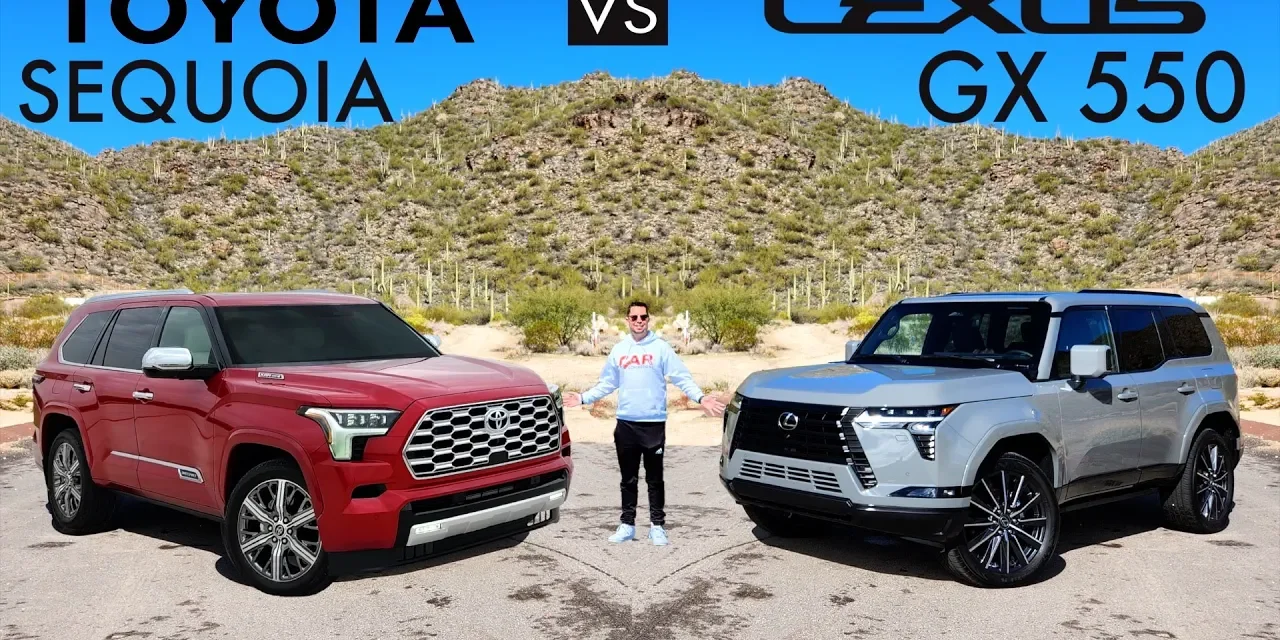
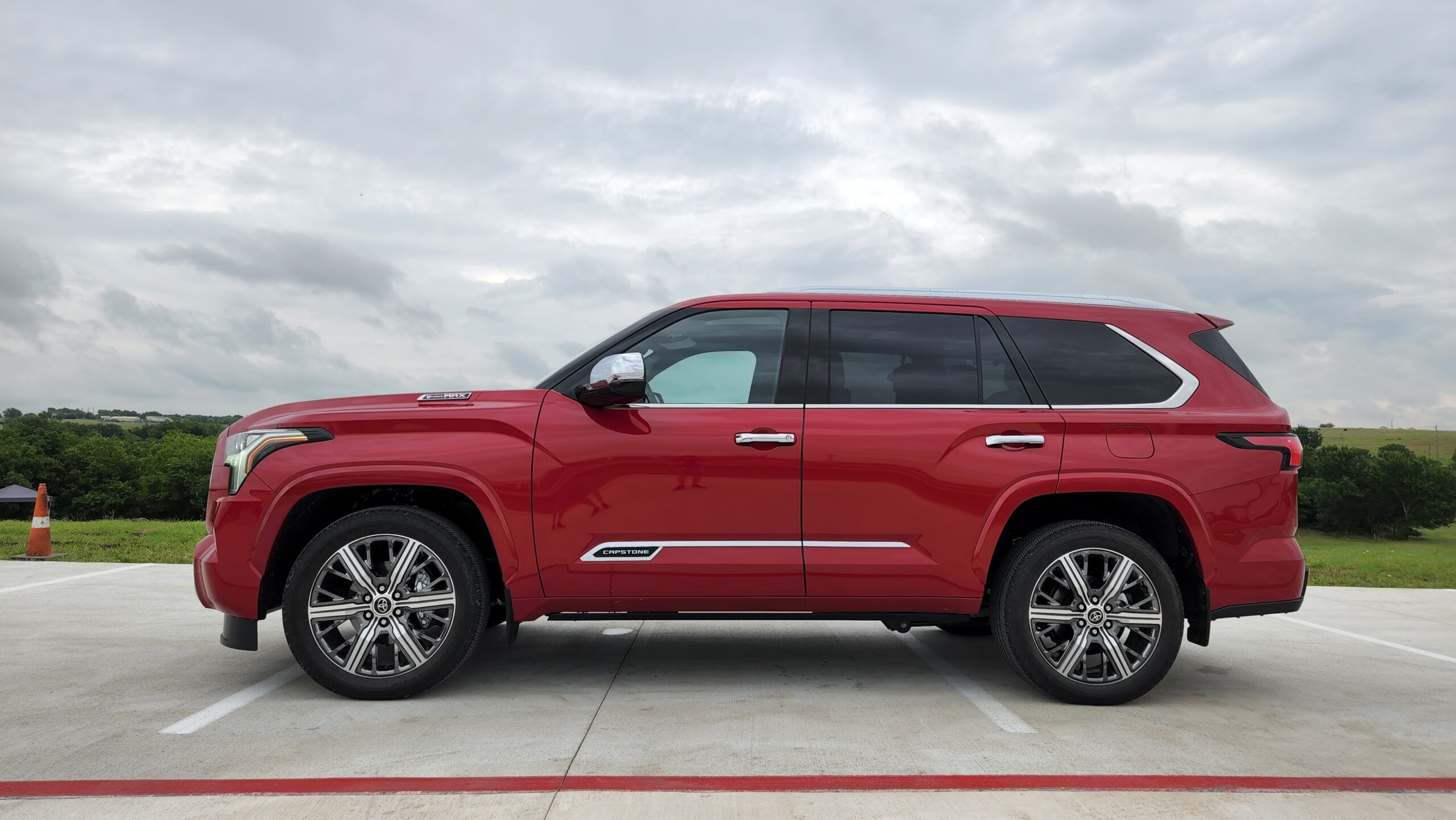
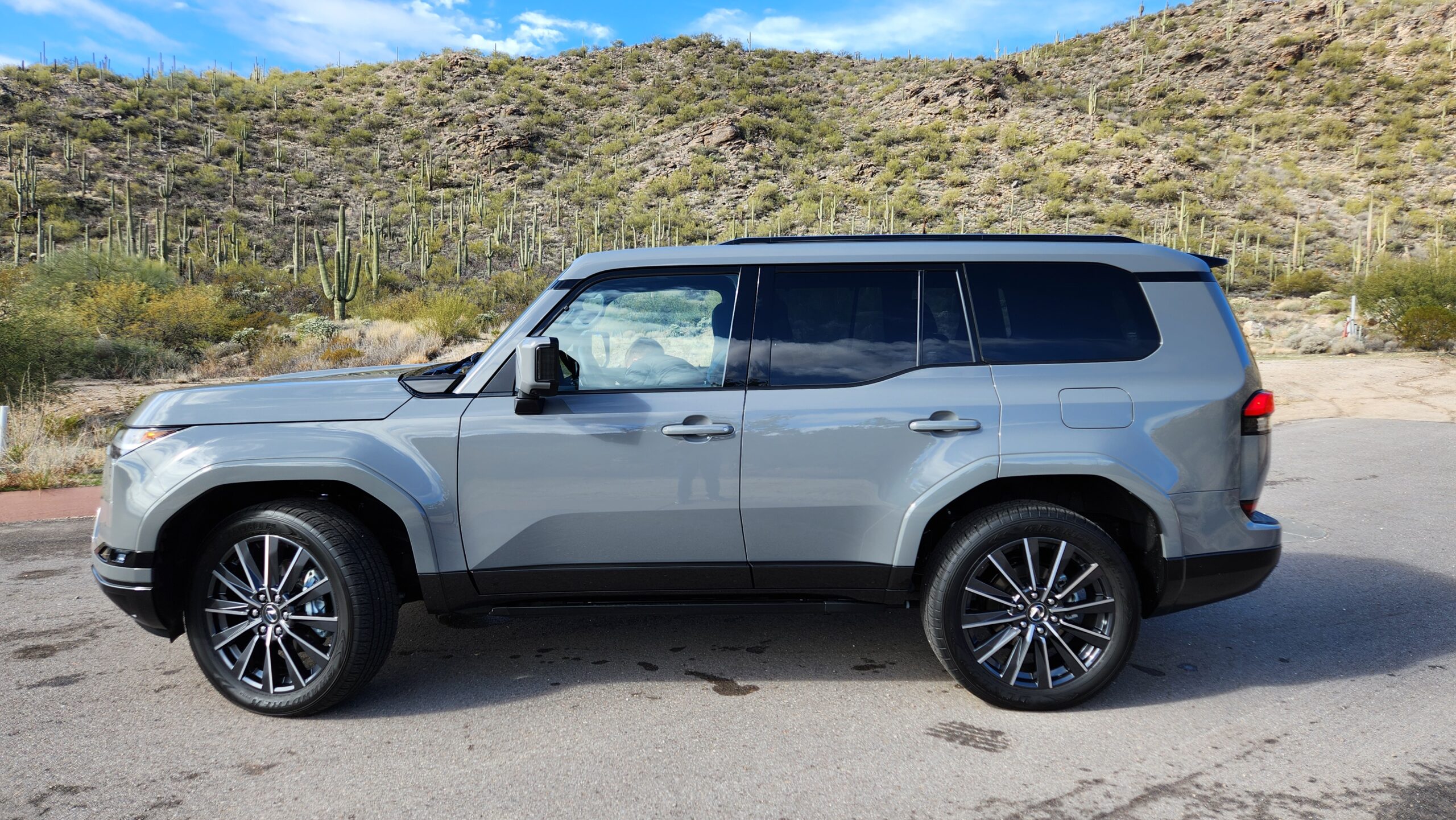
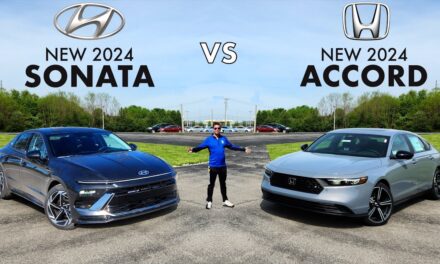






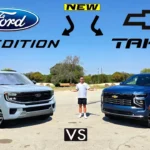


Recent Comments